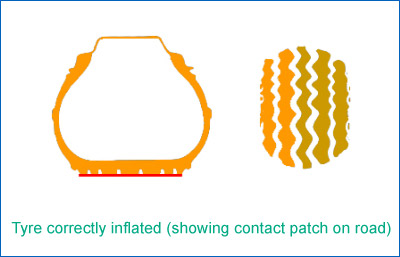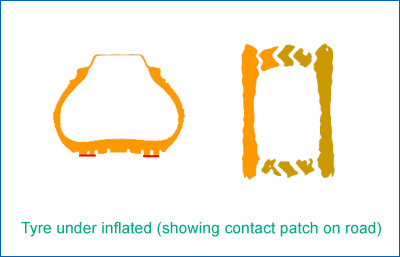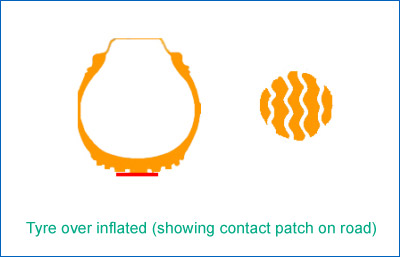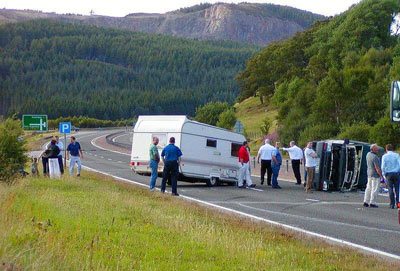Despite issuing advice on maintaining caravan tyres back in June 2008, we saw a 300% increase in tyre related caravan insurance claims between the summer months of July and September 2010 when compared to the number of claims between April and June of the same year. Over 90% of those claims were due to blow outs and the average caravan repair cost in that period was £2,500.
A tyre blow out can cause even the most experienced of caravanners to lose control, and as we have all seen, this can have catastrophic consequences for your caravan as well as putting you, your passengers and other drivers at risk, particularly when it occurs on busy highways such as motorways.
Even if the driver does manage to keep their caravan under control in the event of a blow out, the shredded tyre rotating around the wheel rim can cause major damage to the caravan wheel arch and floor, resulting in hefty caravan insurance claims.
Why the sudden increase in claims when we get to summer months?
- Tyres can suffer damage when a caravan is left unused and unmoved for long periods such as over the winter. The summer months for many owners represent the first time a caravan is used since the previous year. The weight of the caravan resting on tyres for long periods can cause tyres to become distorted – this damage may not be easily spotted but could lead to a blow out. UV light can also cause damage over time and weaken the tyres.
- Old tyres are often prone to blow outs. Irrespective of the tread left on them, it’s advisable to change tyres before they reach 5 years old. You can check the year of manufacture of your tyres. There is usually a code found on a caravan tyre – such as ‘DOT A57C DEF 598’ or ‘DOT A87C DEF 0204’ – the first code’s last 3 digits signify a caravan tyre manufactured in May 1998 and the second code’s last 4 digits signify that the caravan tyre was manufactured in the second week of 2004. Not all tyres have the DOT code but you should be able to find a separate group of digits such as ‘3805’ which signifies the tyre was manufactured in the 38th week of 2005.
- Under or over inflation of caravan tyres can be a huge problem.
Peter Samwell from TyrePal, a tyre pressure monitoring system manufacturer, had this to say:
“The UK Department for Transport statistics show that defective or under inflated tyres are a factor in hundreds of fatal or serious road accidents each year. The latest statistics (Road Casualties Great Britain: 2007 (Annual Report)) records 283 fatal or serious accidents where tyre condition was a factor, making this the most common vehicle defect.”
But why is ensuring your caravan tyres are inflated to the correct pressure so important?
The actual contact patch of rubber with the road is very small even when tyres are correctly inflated. Correct tyre pressure gives best grip and shortest braking distance.

However when they are over or under inflated the contact patch becomes even smaller.
If your caravan has been stood unused over the winter it may be that your tyres have become under inflated. Under inflation is dangerous as it reduces grip and increases braking distance. Cornering is impaired as the tyre tends to roll under the wheel rim. Excess flexing of the sidewall can cause delamination and overheating, leading to a blowout. Note also that under inflated tyres wear faster and can increase fuel consumption by 10% or more.

Over inflation reduces contact and leads to uneven tyre wear.

Peter Samwell added the following advice for inflating caravan tyres,
“Recommended tyre pressures in caravan handbooks are specified for cold tyres, but the tyres warm up when driving, and in normal service pressure increases by about 10%, although caravan tyres often increase by up to 15% because of the extra pressure. Tyres should always be inflated to the recommended level while they are cold.”
TyrePal (www.tyrepal.co.uk) has introduced a system which will enable you to keep an eye on tyre pressures and temperatures of both your car and caravan from your driving seat via a wireless LCD monitor that you can stick to your car windscreen via a suction base. Their system uses valve-cap sensors to transmit accurate pressure and temperature data from up to 22 tyres – so can cater for both single and twin axle caravans. You program your recommended tyre pressures for each tyre and the system will then sound an alarm for any abnormality.

Photo by kind permission of www.transportcafe.co.uk
Caravan Guard’s top tips to avoid tyre related claims are:
- Check your caravan tyre pressures on a regular basis. Check pressures when cold and then make sure the valve is not leaking and valve caps are replaced.
- You could also consider investing in a tyre pressure monitoring system (such as TyrePal) that can monitor car and caravan tyre pressures and temperatures on the go and can warn you in advance of any problems.
- Examine all tyres for sidewall cracks, cuts, impact damage or embedded material at both sides.
- Check the age of your caravan tyres and replace any over 5 years old irrespective of remaining tread.
When replacing tyres, Tyresafe recommend that “only tyres of equal size and service description (load index/speed symbol) and identical wheels should be fitted across an axle and carried as a spare. Tyre pressures across an axle should be equal.” To see their full advice on fitting the correct caravan tyres, visit http://www.tyresafe.org/data/files/caravan%2008.pdf
- As an extra safety measure we also suggest that caravanners fit Tyron wheel-safety-bands . This product has been proven to reduce the risk of accident or damage following tyre deflation. The caravanner remains in control, allowing the opportunity to tow the van to a place where they can safely change the tyre. We offer a 5% caravan insurance discount for fitment of Tyron bands.
- When not using your caravan for several months, if possible try each month to move your caravan or jack up your caravan and rotate the wheels, to ensure that a different part of the tyres take the weight of the caravan.
- If travelling in hot temperatures such as abroad, take regular breaks to stop your tyres getting too hot.


Nice post. It is essential to service the tires too at least once a year. The tips given here are very useful specially installing the tyre pressure monitoring device will surely prove beneficial. Nice.
I have had 6 Motor Homes [all from new] over the past 20 years and I have found it all most impossible to find a tyre pressure gauge or a pump for home or at a service station that will go as high as the pressure that is recommended, please help.
ps most of the service stations on the motor ways do not work at all, and that comes from a lot of truck drivers.
Reference your Email about tyres.
I have been towing Caravans for some 65 years, and you do not mention increasing the pressure in the rear wheels of the Tow Car. I have always increased my rear pressures by 8 to 10 lbs, depending on the size of car, as this increases the stability when towing, never had any trouble. Do not forget to deflate them when you get home.
THERE IS NO MENTION OF WHAT PRESSURE CARAVAN TYRES SHOULD BE. MINE ARE 14 INS THE PRESSURE IS ABOUT 34LBS A SQUARE INCH. IS THIS CORRECT OR NOT.????
Hi Brian,
There’s a complete guide to caravan tyre safety on the Tyre Safe website (see here).
It’s difficult to say what pressure your tyres should be without having more information, but click here to download a safety leaflet which includes information on pressure guidelines and inflation levels.
Thanks
Lucie
having found out the HARD way about tyres standing for 12mths. i now jack up my caravan so that the tyres are off the ground and the tyre is not touching the ground this seems to have cured that particular problem happy towing campers from dave waterfield
Further to my earlier comment about removing my wheels in winter months:I can’t for one minute believe that my caravan tyres,which are stored in my garage for six months of the year,will have deteriorated as much as tyres which have been left on a van in all weathers,at the same time developing a ‘flat spot’.
Many of us consider that the tyre pressures to be important which I do check every time I tow the caravan but what about balancing?
It’s a known fact that new caravans go out from the factory to the dealer and then on to the customer without having any tyres balanced whatsoever. This can cause a bouncing effect which vibrates throughout the caravan causing fixing screws to come loose, damage the external seals, reduce the life of tyre due to uneven wear and in severe cases can cause instabilty too. So whether your caravan is brand new or second hand it is advisable to get the tyres balanced as this problem could well be contributing to punctures and unstable outfits. Some tyre fitters will balance for free when purchasing new tyres but even if they charge it’s worth paying the extra fiver as it not only a money saver in the long term but also a life saver too. It is illegal to travel in the caravan whilst in tow so we are all blind to the fact that our caravan could well be vibrating in transit without any detection at all. Therefore, tyre balancing just is just as important as the tyre pressures but in seven years of caravanning I have never had a blow out. Although I don’t want to get complacent, if a blow out did unfortunately happen then at least I know that I have done everything right to avoid it which is also peace of mind for insurance reasons if my caravan was either damaged or became a total loss.
We balance our car tyres for several reasons so why not our caravan? It makes sense for more reasons than one but it’s best to be safe on the road not only for your own benefit but for other motorists and pedestrians too.
I was advised at my last service to have my tyres changed because they were coming up to 5 years old,even though I take them off and store them in the winter.
What are the regulations for caravan tyres on the continent? Someone has said the our tyres fitted in the UK do not comply with current regulations for use on the continent
Just a cautionary note about winter wheels , some years ago i fitted winter wheels to my brand new end of season bargain twin axle caravan and removed the wheels from the site to my garden shed so the caravan was harder to steal ,and the garden shed was broken into and the brand new wheels stolen ! .To rub salt in the caravan insurance would not cover the wheels as they were not at the caravan ,and my house insurance would not cover them as they were off a trailer or caravan !!.
At the second service cracks in the tyrewall of our Coachman VIP were drawn to my attention. Coachman have so far been unhelpful but I really dont think I should have to go to all the trouble of removing the wheels and fitting the thing to axle stands when its not in use. We have had caravans for over 40 years and not had any trouble until recently. Its my opinion that the tyres should be fit for purpose – that means they should be able to withstand a few sun rays and not being used in the winter. The truth of the matter would seem to be that the manufactures fit the cheapest tyres they can find from anywhere around the globe and to Hell with the consequences
Thanks for everybody’s comments on this,
Geoff – just wanted to clear this up for everyone.
We have no problem with customers using axle stands during the winter, but would require the wheels to be completely removed and stored securely away from the caravan. If you were using axle stands without removing the wheels then we would require you to fit a wheelclamp as normal, which is obviously fairly impractical, which is partly why removing the wheels completely is the best option. This also has the added benefit that the tyres are less likely to become damaged by cold weather conditions over winter.
‘Winter wheels’ are a good alternative to using axle stands and removing the wheels, as they not only protect your tyres from damage over winter but also provide additional security as they are tricky for thieves to remove.
In both cases a hitchlock, and any additional security required by the terms of your policy, would still be required to be fitted and in full working order at all times.
Neil, Caravan Guard
I agree about axle stands,when not using caravan in winter.
I purchased a pair,only to be told by Caravan Guard,my insurance would be invalid.I admit it was awhile ago,so things might have changed now.
So if you are thinking of using them,check your insurance first.
I try to caravan all through the winter,so it really is not an issue for me now.
We have just recently bought a twin axle with movers fitted. Checked the tyres and found slight cracking on sidewalls. Tyres dated 05 on a 2007 van.
Had 4 new Michelin tyres fitted, 100 miles from home on first run out, on A1M drivers tooting and pointing to rear. stopped and found nothing at rear of van. Drivers soon tooting and pointing at rear, stopped again and found front tyre on the nearside sliced round the centre and well shredded.
Never felt anything was wrong, biggest problem getting off the road where we could get the spare fitted in safety. All ends well.
Excellent advise – just had Tyron Bands fitted to out Twin Wheeler…..
I purchased a heavy duty 12v compressor from Halfords , a bit expensive , about £50.00, but worth it since it will inflate to high pressure and only takes up a little bit of space in the car
I think the reason people don’t often check their tyre pressures is the fact that it’s not very easy to inflate them. By this I mean that at most garages its impossible to get your van to the pump without removing the caravan wheels completely from the caravan. I know that you can purchase 12v systems however these systems do not work very well with the high pressure required for my caravan ie. 60lbs pressure. The small electrical device tends to overheat or burn out before getting to this pressure. Does any body have advice as to a suitable advice at a reasonable cost. It could be that caravan guard may offer a suitable device at reasonable cost to policy holders?:
Good point Charlie.
I’m not sure if 100% suitable but it seems the all in one battery jumpstarters with built in air compressors will inflate tyres up to pressures of 260 PSI which I think is a lot more than the stand alone 12v digital air compressors. Click here to see one we found for less than £30.
No plans at present to run an offer on such products, though it does sound a good idea so we might be able to do something in the future.
Craig, Caravan Guard
I went recently to have a look at my spare tyre slung underneath my caravan and witn help from my brother-in-law pulled the frame out, only to find that when I had the van serviced the mechanic had put the spare back with the valve resting against the frame, with the result that the valve stem had fractured, leaving the tyre practically flat. Moral is, check the spare as well as the other two tyres, its too late on the motorway !!
I am a little suprised to see no mention of removing tyres during the winter storage season and leaving the van on axle stands. This offers a little bit more security for the van during storage and allows the wheels to be kept in a garage or even in the van laid on their sides.
Brian
Great suggestion about using axle stands/winter wheels.
Good for the health of your caravan tyres and also a great deterrent to would be thieves. From a security point of view better to keep the removed wheels away from the caravan, so your suggestion of a locked garage is a good one. Alternatively a locked shed or even inside the house if possible.
Thanks for your comment.
I noted the bit about looking for the date of manufacture of the tyre. Being very keen about maintenance of my own vehicles it is something that I am well aware of. On occasion it can tell its own tale giving a clue to the true age of a vehicle.
A tyre can only be described as “new” if it is less than 2 years old. So if a caravan with 12 month old tyres when it was built, then stood for 15 months at the dealer before it was sold it would not have “new” tyres. Is this then still a “new” caravan as the tyres are not deemed to be new according to the tyre industry.
I noted that the 2 caravans that I had (both from new) before my current one had the tyres fitted (from new) with the date on the inside, so it was very difficult to read. I did wonder if this had been intentional to conceal the age of the tyres. Or am I being too cynical?
Anyway, what I am getting to is that if you don’t see the date code on the outer tyre wall, have a look at the inner wall. It has to be on the tyre somewhere.
“2 years ago idid as many have before my caravan a 1999 Eccles Moonstone with tyres that looked fine. Serviced and maintained we set off for cornwall.After a great holiday as usuall we had driven all the way back to Yorkshire and were passing Scamonden Dam on the M62 a sudden vibration was the only clue to a blown tyre. Thankfully my outfit held true and i was able to pull up on the hard shoulder with little drama.The tyre was shredded with little to show, The wheel spat was damaged and the inner arch required repair… I will never commit this sin again i knew the age of the tyre I have carravaned for 35 years travell the continent regularly.. I gambled and lost this time it cost a few pounds thankfully not my life.. I won’t do it again.
Having twowed alsorts of trailers from single axle to tri axle traiers most of my driving life.Lasat year upgraded from trailer tent to caravan,I would say checking tyres is common sense.how often do people check their car tyres once amonth at least.I check my caravan tyres evry time I use it.You see so many people on side of road scratching there heads because they have a flat on caravan .Mostly because its through there own fault CHECK TYRES EVERY TIME YOU TOW IT!!!!
We have a twin axle van fitted with a motor mover and last year on our way to the south of france our mover caught a lump of concrete sticking out of the ground at a petrol station. We had to get a mechanic to release the mover and little did we know he should have changed that particular tyre as the inner band had been damaged, this we found out a couple of hours later when we had a blow out and nearly lost the side of the caravan as it swerved over towards the concrete sidings on the road. Fortunately with having twin axle all the damage caused was wheel arch on caravan and alluminium side trim. Had we have had a single axle van we would have lost the lot. So yes it does pay to have your tyres checked even after incidents like ours.
Excellent advice, Tim.
It’s easy to check the outside of the tyre – the bit we can all see – and forget about the inner walls. You may need to remove the wheels to carry out a proper inspection, but worth adding to the servicing ‘to-do’ list at least once a year.
check the inside wall of tyre,the square type speed bumps can damage tyre walls,because of the caravan tyres stradle the speed bump,scrubbing the tyre wall.